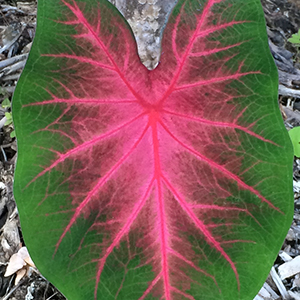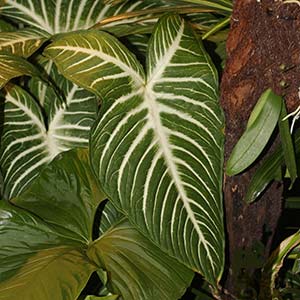
With large colourful heart shaped foliage Caladiums are a favorite foliage plant in warmer climates. Grown from bulbs or rhizomes, they are easy care in warmer climates and can be grown in cooler areas as well.
Although they will take a little more care in less than ideal conditions many gardeners in cooler areas grow them as well.
They are from Brazil and are loved for the colourful foliage, most prefer filtered light although some new cultivars grow well in sun as well.
Modern Caladium cultivars originate from around 12 species, they have been extensively hybridized and with large heart shaped leave now come in 1000s of cultivars.
Caladiums will die right back in winter and require a dry winter. Some gardeners leave them in containers over winter and stop watering, they do need to be ‘just damp’. If left wet during dormancy they usually die

Caladiums will flower, the flowers are attractive and typically white and hooded, however it is usually the foliage that they are grown for. Propagation can be carried out by cross pollination and sowing the seed.
Care
Easy care in warmer climate, the main trick with Caladiums is to provide excellent drainage, moisture and some humidity.
Often grown as an annual they can be planted on warmer Zones in April, Colder Zones in July. As a guide wait until after the last frosts.
- Growing medium
Try a good quality 65% terra cotta and tub potting mix with a 25% mixture or medium pine bark, gravel and charcoal mixed in to improve drainage. Add a 10 % coir peat to help retain moisture. - Planting caladiums
Tubers should be planted in spring but wait until the soil begins to warm up. Plant at around 10 cm deep, you will see growth nodes or ‘eyes’ on the tubers and these should be pointing upward. A little fertilizer at this stage is OK, some blood and bone or liquid seaweed fertilizer works well. - General Care
During the growing season keep moist but not wet, a weak application of liquid fertilizer every two weeks will promote healthy growth. An application of slow release fertilizer as soon as new growth begins is also recommended. - Light and Sun
Some varieties cope with more sun than others, generally a filtered light is best, those that do cope with sun will also require more water during the growing period. You will also find that plants will vary in foliage color and size depending on the amount of sunlight. - Over wintering caladiums
At the end of the growing season foliage can be cut back ready for winter.
Growing Caladiums Indoors
It is difficult to grow Caladiums indoors, and this is because of the humidity that they require.
Try the following steps
- Grow best in bright but indirect or filtered light – never direct sun.
- Never let the soil dry out, yet do not let it become soggy.
- Keep the humidity high by placing the plants on a saucer of water filled with pebbles, or by using a humidifier and also by growing them in groups so they create a little humid microclimate.
Caladium Varieties
Basically Caladiums are either one of two types with a multitude of colors.
- Strap Leafed Types :
The stem comes from the edge of the individual leaf. They have long lance shaped leaves, and are regarded as more tolerant of the cold. They are slower to multiply than the Fancy leafed types and are lower growing. - Fancy Leafed Types:
The stem comes form closer to the centre of the individual leaf. Leaves tending to be broader and best described as heart shaped. They are more suited to warmer climates. Taller growing.
Colors range from white through to red and pink with many multicolor types as well. So expect anything from pink foliage through to deep green with almost fluorescent pink spots.
Propagation
Propagation is by division of tubers.
Where to buy
You can find Caladiums for sale at most good nurseries from spring to summer
BRENT and BECKY’S BULBS – Ordering: (877) 661-2852
7900 Daffodil Lane Gloucester, VA 23061

